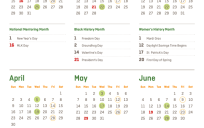
Recent Articles on GovLoop
- How Can Agencies Strengthen Their Defense Against Insider Threats?
- Process Automation: The Efficient Alternative to Paper-Based Systems
- Fostering Creativity on Your Team
- How to Shift to a Continuous Modernization Mindset
- How to Build a Better Endpoint Security Strategy
- How Cross-Skilling Can Help Address IT Skills Gaps
- Learn Something New With Our April Online Training LineUp
- Why Network Modernization Tops the IT Agenda
- Digital Transformation: How to Reduce Internet Connectivity Risks
- Beyond Zero Trust: How to Strengthen Your Data Resilience




The answers to this poll bug me a little bit. It just shows that people don’t really think things through. I mean taking care of energy needs could remedy or at least has the ability to put a dent in all the other problems on this list sans illegal immigration. In government we should always be aimed at the efficient approach but instead one issue voting forces the hand of lawmakers. Not trying to rip, but problems are almost always connected and if we are analytic about we can normally nail down the best fix instead of the quick fix.
@Stephen Peteritas- very well said. I agree with you, (but that is very hard to communicate in poll).
Yes, I agree that most survey polls are presented as a sequential and independent questions, but that is often not the case. It’s a little like brainstorning first impressions and relies too much on getting some ranking that provides a hard number.
Bit much better approaches take time. One example is the use of “cognitive interviews” in questionnaire development another is just a look for what seems to be errors. This allows the developer to detect items that are not understood by respondents in the way they are intended by the survey developers.
Cognitive interviews can be also used to revise or develop items so they are more appropriate to respondents’ cultural context and lifestyle.
Generally, cognitive interview methods reflect a simple, theoretical model of the survey response process in four steps:
1. comprehension or interpretation,
2. information retrieval (can be affected by context that primes some items),
3. judgment formation, and
4. response editing (easy if selecting a categorical box, but may be free to write in a response).
Obviously the respondent must first understand the question, then recall information, then decide upon and examplain its relevance.
An old cognitive interview technique is to ask respondents to Cognitive interviews are used widely in questionnaire development to detect items that are not understood by respondents as intended by the survey developers. Cognitive interviews can be used to revise or develop new items so that they are appropriate to respondents’ cultural context and lifestyle. Cognitive interviews are used usually during the pre-testing phase of a survey. Results of cognitive interviews illustrate the types of errors made by respondents, and how they interpret and answer questions. Generally, cognitive interview methods reflect a theoretical model of the survey response process that involves four stages: comprehension or interpretation, information retrieval, judgment formation, and response editing. In other words, the respondent must first understand the question, then recall information, then decide upon its relevance, and finally formulate an answer in the format provided by the interviewer. One cognitive interview technique is to ask respondents to think aloud/verbalize their thoughts while answering survey questions. In this way we can see if the respondents are thinking of the relationship between items for not. But as is obvious such analysis takes time.
See Beatty P. The dynamics of cognitive interviewing. In: Presser S, Rothgeb JM, Couper MP, et al., eds. Methods for testing and evaluating survey questionnaires. Hoboken, N.J.: John Wiley & Sons, Inc.;2004:45-66. for more.
Beatty P. The dynamics of cognitive interviewing. In: Presser S, Rothgeb JM, Couper MP, et al., eds. Methods for testing and evaluating survey questionnaires. Hoboken, N.J.: John Wiley & Sons, Inc.;2004:45-66.